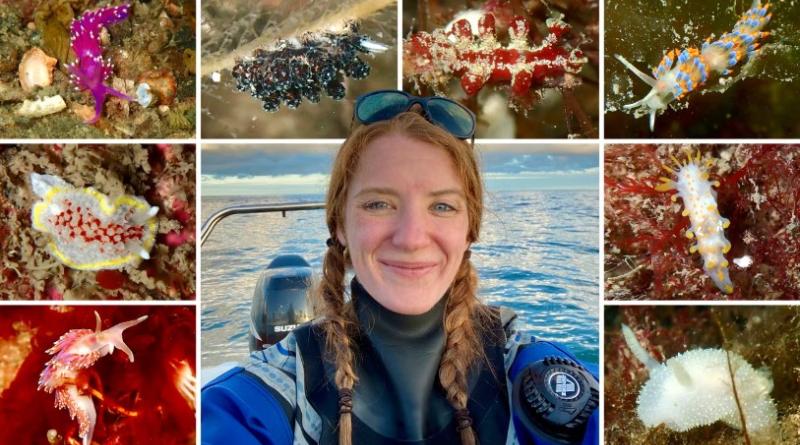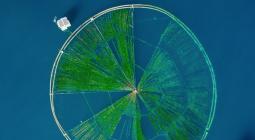‘They’re inherently charismatic’: the amateur sleuths hooked on sea slugs

More and more enthusiasts have fallen in love with this relative of garden dwellers, and are helping ocean science while they’re at it
Two years ago, Libby Keatley was diving off the coast of County Antrim in Northern Ireland when she spotted something unusual. It was a sea slug – or nudibranch – whose transparent body had orange lines running through it and twiggy projections arranged along its back. “It was quite distinctive and not like anything I’d seen before,” she says.
Keatley called over her diving buddy, Bernard Picton, a local marine biologist and pioneer in UK sea slug studies. He scooped it up in a plastic bag and, back at his lab, confirmed it was a newly discovered species. He named it in Keatley’s honour: Dendronotus keatleyae.
“Three years ago, I didn’t really know what a nudibranch was or I thought they only lived in tropical countries,” says Keatley. “It just shows you can learn – you don’t have to be somebody who’s been in a lab for 20 years to know that something looks a bit funny or different.”
For a niche but growing group of amateur naturalists, sea slugs have become an ideal subject: as stunning as butterflies but with the good grace to sit still while you peer in close and take a photograph. Distant relatives of the slimy, drab land-dwellers that live in gardens, sea slugs are an altogether more endearing bunch. Many are daubed in jewel-like colours that warn off predators. Others take on hues to blend in with their surroundings, often gaudy seaweeds and sponges.
There are also plenty of sea slugs to discover in UK waters, with about 150 known species across the north Atlantic. And being so small – generally under a finger’s width – there’s a thrill to be had in spotting one. “That’s what I love about them,” says Keatley.
To show me why the hobby has attracted a worldwide community of scuba divers and amateur photographers – and how it makes important contributions to scientists’ understanding of how our oceans are changing – Keatley takes me diving in Strangford Lough. An hour’s drive south of Belfast, it is one of Europe’s largest sea inlets and a renowned wildlife spot, home to seabirds, seals and recently a pair of bottlenose dolphins.
There’s even more going on beneath the waterline. At high tide, the Irish Sea brings in a soup of particles and nutrients which feeds a rich mix of underwater species – and a host of other creatures that feed on them.
Keatley gazes out across the unpromising green, murky water. “There’s a whole other world just under the surface,” she assures me.
We are joined on the dive by Keatley’s partner and fellow enthusiast, Phil Wilkinson, and Picton, who recently updated a guidebook to sea slugs of the north Atlantic with Christine Morrow, who is keeping watch from the shore. “I think the nudibranchs are very easy to get people hooked,” she says. “There’s something inherently charismatic about them.”
We squeeze into dry suits, neoprene gloves and hoods, heave on scuba gear and lead weights, then lumber into the water. Ten metres down, the sea is a face-numbing 10C and I can see no further than a few metres. But after a few minutes, Keatley points out a tiny sea slug that looks like a cluster of powder-pink raspberries.
We find more sea slugs than I’ve ever seen, even in tropical seas: neon pink ones and transparent ones covered with finger-like projections with shiny turquoise tips; another is white with yellow specks and a pair of bunny ears that are for smelling not hearing. We encounter a gathering of sea slugs that look like miniature fried eggs splashed in chilli sauce, and Keatley points out a peach-coloured specimen hitching a ride on a hermit crab. It feeds on minute hydroids – stinging relatives of jellyfish – that grow on the crab’s shell.
For Keatley, sea slug spotting was part of an unexpected reawakening of a childhood interest in nature. In January 2019, she learned to scuba dive and was an instant convert to the underwater world. “I couldn’t get enough,” she says. “The more I saw, the more I wanted to learn, and then the more I was seeing. So it just snowballed a wee bit.”
Keen to share the enchanting wildlife with friends and family, Keatley got a waterproof camera and began posting images on Instagram. She gets help in identifying species from other enthusiasts and exerts on Facebook groups.
Within a year she was a fully qualified diver and started volunteering with the Northern Ireland branch of Seasearch, a citizen science group of divers and snorkelers who gather information about species and habitats. Data from their surveys are checked for accuracy then fed into a national biodiversity database, NBN Atlas.
“On the first dive I went on with Seasearch I thought, ‘I’ve found where I want to be. These people are interested in the same things as me,’” says Keatley. “I wanted to give something back and do something useful for this place that I love.”
Throughout summer and autumn, she and fellow Seasearch divers carry out underwater surveys of the Northern Ireland coasts at least once a month. It was during one of these, in 2021, that Keatley found the new species of sea slug. Between dives, she helps organise online talks and workshops to teach volunteers identification and photography skills.
Terry Gosliner, a veteran nudibranch specialist from the California Academy of Sciences, has helped name hundreds of species. He champions ordinary people who are helping to find and study sea slugs. “We don’t have enough scientists to observe what’s going on,” he says.
Citizen science has a long history, especially among British amateur naturalists such as Charles Darwin. It’s now taking off – for sea slugs and more generally – Gosliner thinks, because of all the internet forums, Facebook groups and online communities such as iNaturalist that allow experts and amateurs to work together to identify and map species. There are also underwater photographic competitions and “shootouts” with special categories for the best nudibranch pictures. Citizen scientists can see the direct results of their observations, which makes them more likely to stick with it, Gosliner notes. “I think we’re in a golden age of really understanding the importance of citizen science.”
This is not just about finding new species but also documenting their movements as the planet heats – and sea slugs are on the move. In August 2022, a rainbow-coloured sea slug was seen by a Seasearch diver in the Isles of Scilly, a first for the UK. The species is commonly found in France, Spain and Portugal and was spotted again in May this year, in a rockpool on a beach in Falmouth.
Last June, Keatley spotted a sea slug off the coast of County Donegal in north-west Ireland that previously was only recorded as far north in the UK as Pembrokeshire.
“If you know your nudibranchs at all, it’s quite distinctive. It’s not as if you would confuse it with anything else,” she says.
Gosliner says citizen scientists are often the first to notice species showing up in unexpected places. “We rely on ordinary people,” he says, “who have strong interests and strong expertise, to help make those observations and be the sentinels of environmental change.”





